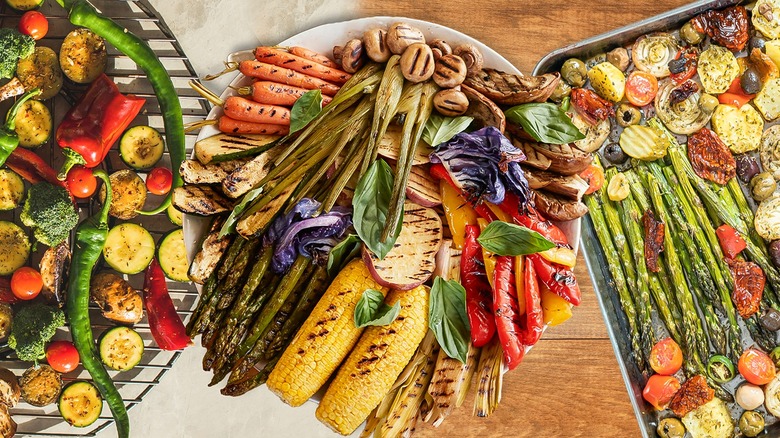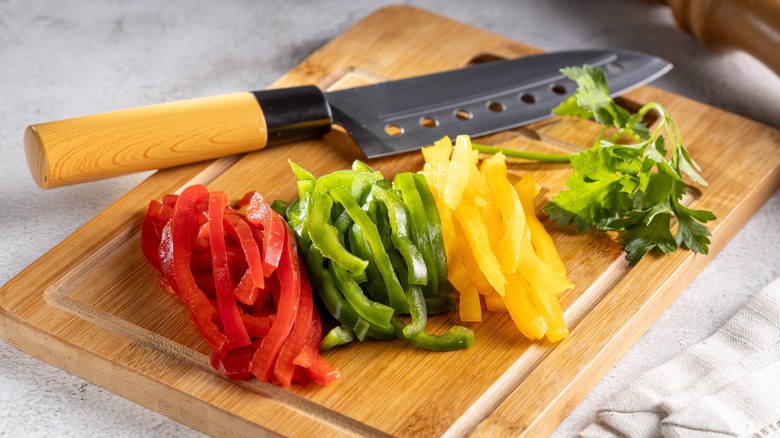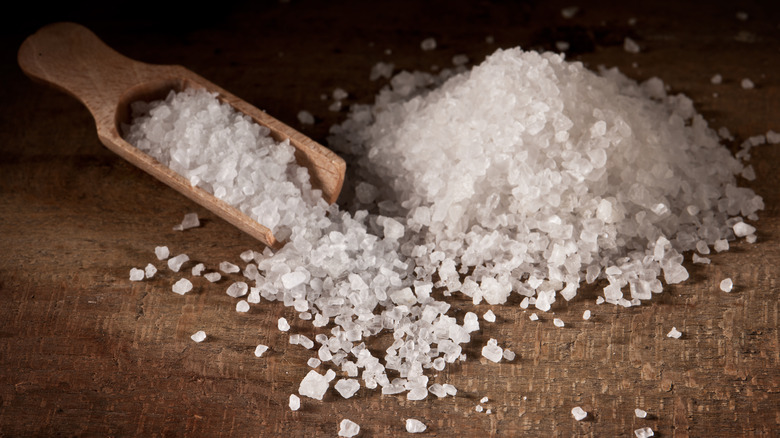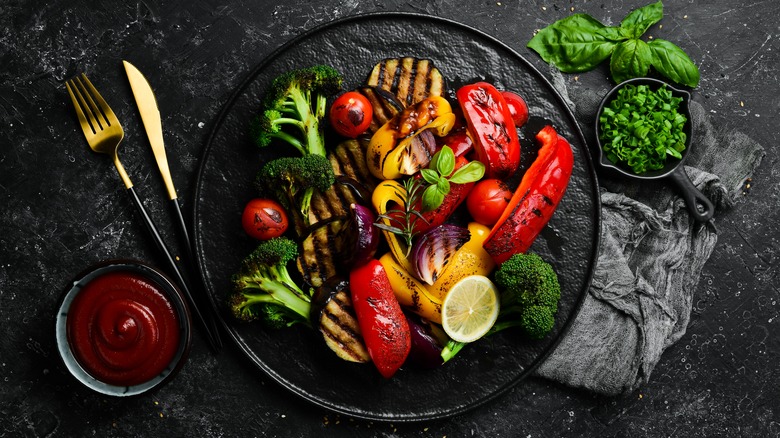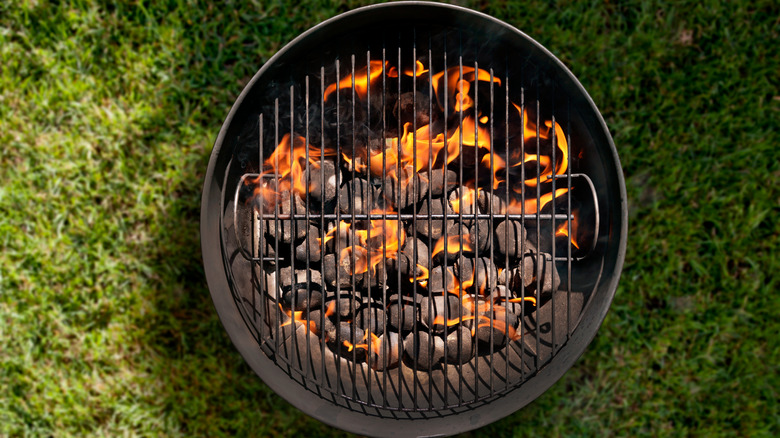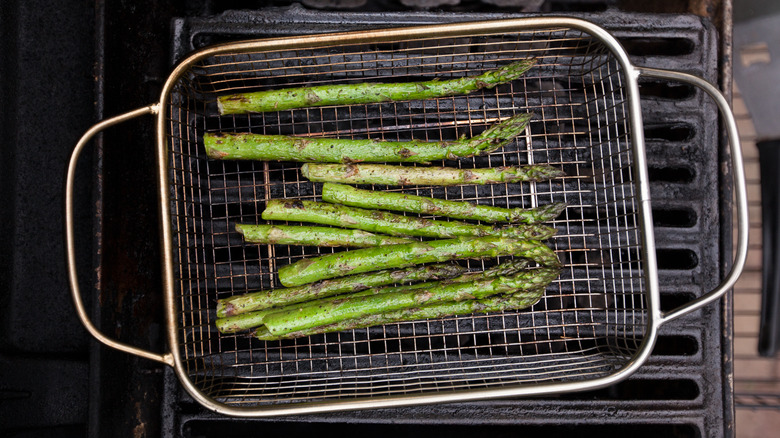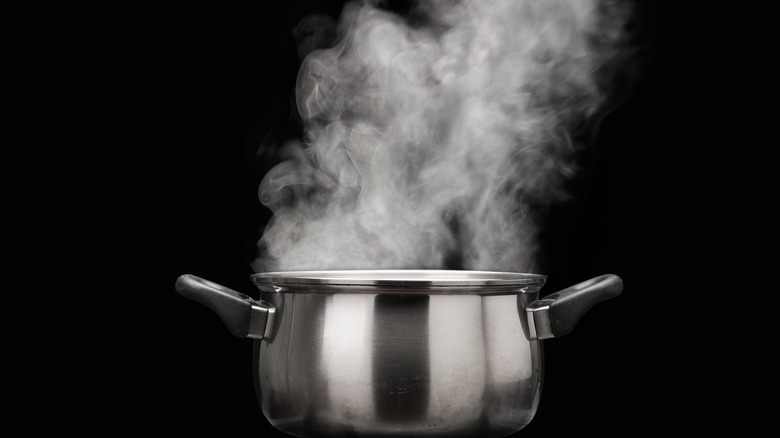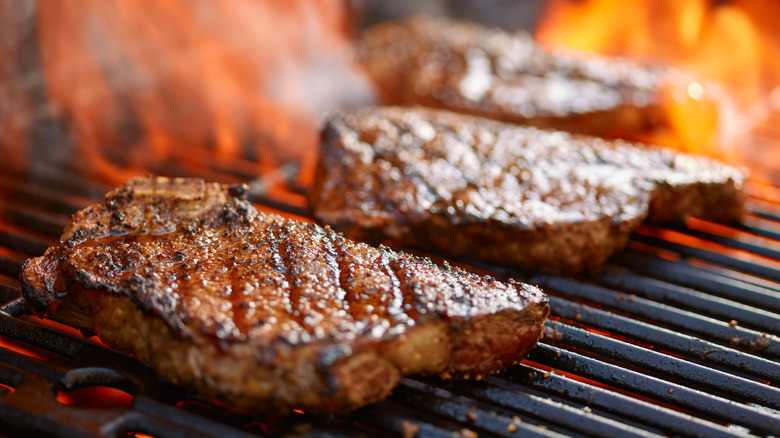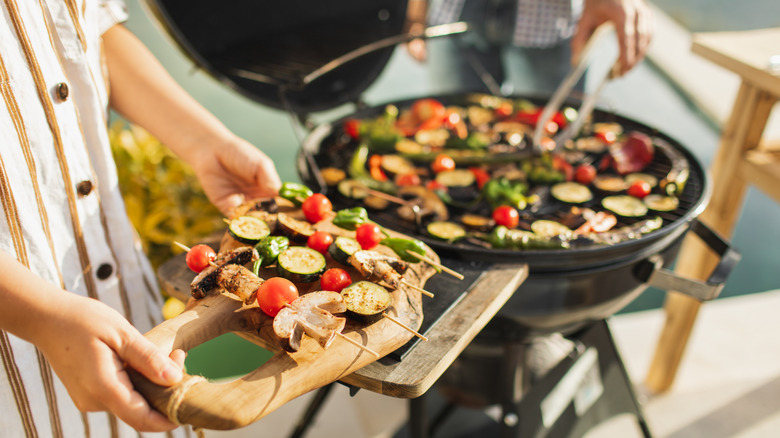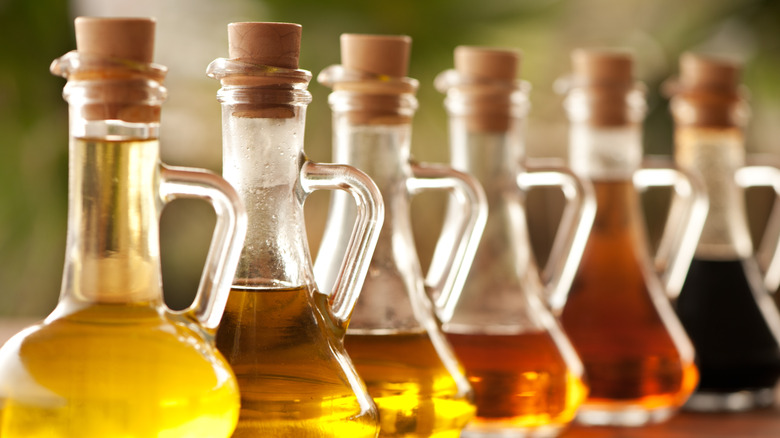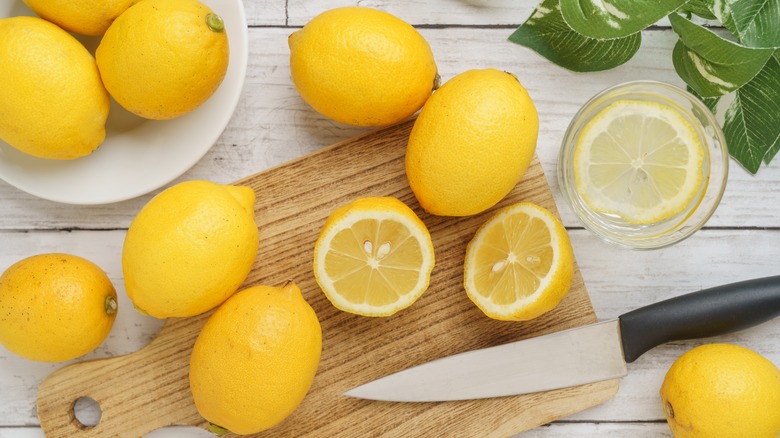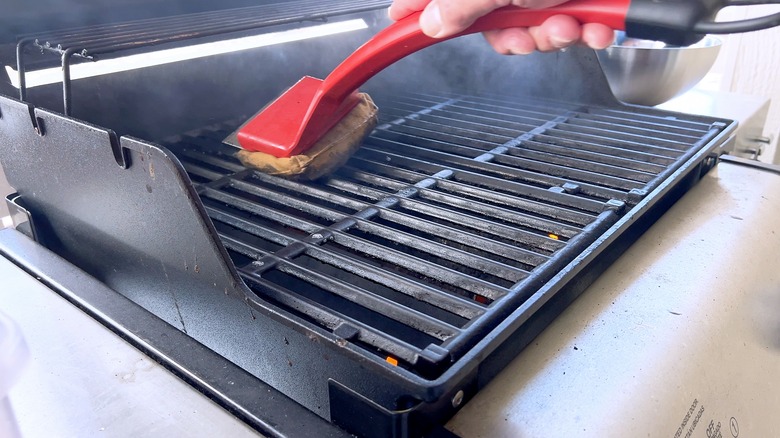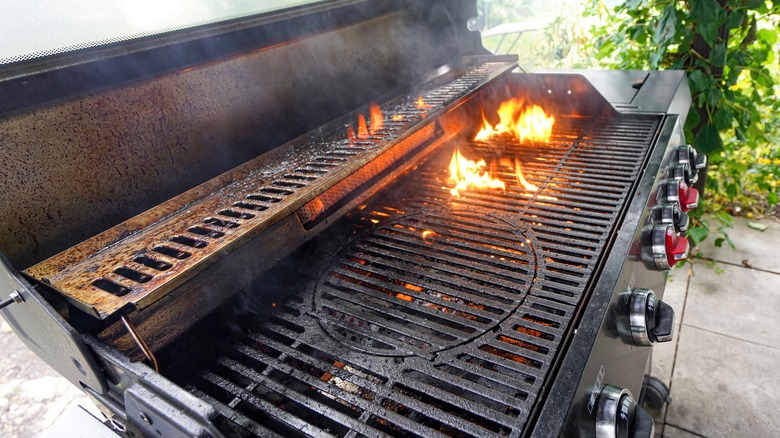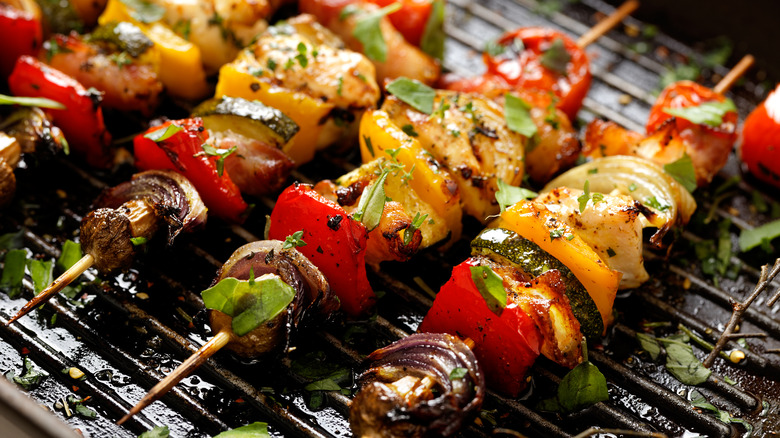13 Tips You Need To Grill Better Vegetables
The art of grilling vegetables goes beyond just tossing them on the grill. With the right approach, you can turn simple veggies into standout side dishes or even the main event of your meal. To achieve that perfect blend of crispness and tenderness, there are several essential techniques you need to master. Whether you're preparing a weekend barbecue for family and friends or simply looking to enhance your weeknight meals, knowing how to grill vegetables effectively can make a huge difference.
Grilling vegetables over an open flame imparts a unique, smoky flavor that you just can't get from boiling or pan-frying. The high, direct heat caramelizes the natural sugars in the veggies, creating a delicious char and enhancing their taste. However, there's no one-size-fits-all method when it comes to grilling vegetables. To get the best results, you'll want to keep in mind what makes each vegetable unique and tweak the techniques to match.
From how to apply heat to how you handle the vegetables before and during grilling, every step plays a crucial role in ensuring your veggies cook evenly and retain their best flavors. To provide you with top-notch advice, we've interviewed experts Chef Liam O'Connell, executive chef at the Wisconsin Club, and Chef Greg León, owner and executive chef at Amalina, who share their insider tips on marinating to infuse vibrant flavors, selecting the right oils to prevent flare-ups, and mastering heat zones for that ideal sear. Armed with these strategies, you'll be ready to impress with vegetables that are perfectly grilled and bursting with flavor.
Make sure they're evenly sized
Achieving perfectly grilled vegetables starts with a simple but under-utilized step: Cut them into uniform pieces. Taking the time to chop your vegetables to a uniform size might seem like a small detail, but it can make a significant difference in your grilling results. Chef Liam O'Connell emphasizes this point: "The most common mistake, in my opinion, is either having pieces that are either too small or too large. Uniformity will help ensure an even cooking time. Also, cutting vegetables so they have a flat, even surface helps ensure they aren't rolling around causing an uneven cook."
Chef Greg León agrees. "Inconsistent sizes lead to uneven cooking; smaller pieces might burn while larger ones remain undercooked. For example, slice zucchini into even rounds or cut bell peppers into similar-sized strips." This technique leads to even heat distribution for your veggies so that each piece will have the same chance to develop that desirable char without leaving some pieces overcooked or underdone. Get those veggies chopped just right, and you'll be savoring consistently delicious, perfectly grilled bites every time.
Don't put salt in the marinade
When it comes to grilling vegetables, how and when you add salt can make a big difference in the final result. Chef Liam O'Connell advises steering clear of salt in your marinade. "Salt should be applied to the vegetables right before they hit the grill," he explains. The reason behind this is twofold. First of all, salt in the marinade can lead to overly salty vegetables if they soak for too long. Secondly, and more importantly, "salt draws moisture out of the vegetables," says O'Connell. "When you are marinating something, you want flavors and moisture going in, not out."
However, O'Connell also notes that there are exceptions to this rule. For vegetables with high water content, like eggplant, "you want to season them ahead of time to help draw out some of the moisture, which will help prevent mushiness" during grilling. This also applies to other water-rich vegetables like zucchini, bell peppers, and asparagus. Aside from these exceptions, it's best to stick to the original approach of leaving salt out of your marinade for the most ideal results.
Avoid moving the vegetables much while they're grilling
A common mistake when grilling veggies is moving them around too much as they're grilling. It might be tempting to keep flipping them, but Chef Liam O'Connell advises against this. "The real secret is having patience and letting the char develop." Constantly shifting them can prevent even cooking and disrupt the caramelization process, where much of the smoky flavor comes from.
Instead, place your vegetables on the grill and resist the urge to fidget. Focus on other tasks, like preparing your meal's main course or setting up other side dishes. During this time, you'll slowly but surely develop those beautiful grill marks and deep flavors. Whether you're grilling hearty vegetables like bell peppers and zucchini or more delicate ones like asparagus, patience will truly pay off. So resist the urge to micro-manage your veggies and let them be until it's actually time to flip them.
Create heat zones on the grill
To achieve perfectly grilled vegetables, mastering heat management on your grill is a hidden key. Instead of applying uniform heat across the grill, setting up distinct heat zones can help you cook vegetables more effectively. Liam O'Connell says it's important to have "a hot side and cooler side of the grill for things of this nature." He recommends starting them "on the hot side to develop a little char and moving them to the cooler side so they don't overcook." Chef Greg León adds, "Starting with direct heat gives the vegetables a quick sear, while finishing with indirect heat allows them to cook through without burning." According to O'Connell, this approach also helps to "avoid over-charring vegetables before they finish cooking."
To properly set up grill heat zones on a charcoal grill, arrange the coals on one side to create a hot zone and leave the other side without coals to form a cooler zone for indirect heat. Using a gas grill, simply preheat one side of your grill on high for direct heat and leave the other side on low or turn off one burner for indirect heat. By mastering heat zones, you can achieve a balance of crispy, caramelized exteriors and perfectly cooked interiors, taking your veggie grilling game to new heights.
Use a wire roasting rack or grill basket
One issue that many people face when grilling vegetables is how to keep them from falling into the fire. This is especially true for veggies chopped up in smaller pieces or for those that are a bit flimsy no matter how you cut them (we're looking at you, perfect asparagus). Thankfully, there are a couple of easy solutions to this issue. Chef Liam O'Connell prefers grilling on a wire roasting rack, noting that "it helps prevent small pieces from falling through the grates while still allowing them to grill." Unlike a sheet pan, which can block the direct heat and smoky flavor, a wire rack lets your veggies develop that coveted char while keeping them safely above the flames.
Chef Greg León similarly recommends using a grill basket, which functions much like a wire roasting rack. He points out that it's especially useful for "helping ensure even cooking, preventing sticking, and making handling the vegetables easier." A grill basket or wire rack allows the heat to circulate around the vegetables more evenly. Plus, using these tools keeps your hands safely away from the hot grill, reducing the risk of burning yourself in the process.
Keep a pot with water in it on the grill
Grilling vegetables can be a bit tricky, especially when it comes to maintaining their moisture. The high, direct heat of the flames that gives vegetables their delightful char also tends to draw out their natural juices, leading to dryness if you're not careful. This is because the intense heat causes water inside the vegetables to evaporate rapidly, which can leave them shriveled, less flavorful, and more prone to burning.
Chef Liam O'Connell suggests a simple but effective way to deal with this issue: Keep a pot or pan filled with water on the grill next to your vegetables. This will "create steam to help them cook a little quicker in a moist environment," says O'Connell. The added moisture from the steam counteracts the drying effects of the grill's heat, making sure your vegetables don't lose their natural texture and flavor. That retained moisture also allows for more even cooking, especially when dealing with thicker vegetables like sweet potatoes or carrots. As the steam envelops the vegetables, it gently cooks them from all sides, reducing the chances of unevenly charred spots or undercooked centers.
Grill proteins before vegetables
Grilling proteins before vegetables is a smart strategy that can simplify your grilling process so that all elements of the meal are well-timed and perfectly cooked. "Usually, I will cook the proteins first and allow them to rest, then cook the vegetables. You can always put the proteins back on the grill briefly to warm them back up without overcooking them," advises Liam O'Connell. This technique not only streamlines the grilling process but also enhances the overall dining experience, with every element of the dish being served hot and at its best.
Chef Greg León adds that "meats and vegetables often have different cooking times and heat requirements." This means that grilling vegetables alongside meats can easily lead to overcooking some of the grilled items. By grilling proteins first, you avoid this issue altogether. Instead, you can focus on each component of your meal individually so that both the meat and vegetables reach their optimal doneness.
Marinate but don't over-marinate
Marinating vegetables before grilling is an excellent way to infuse them with flavor and keep them moist, but it's essential not to overdo it. When it comes to oil, Chef Greg León recommends a gentle hand. "A light coating of oil helps vegetables caramelize and prevents sticking, but too much oil can lead to flare-ups and burnt spots." León also has some astute advice about marinades: "Avoid marinating for too long — especially with acidic marinades — as it can make vegetables mushy." Acidic ingredients like vinegar or citrus can break down the vegetables' structure if left on too long, leading to an unpleasant texture. He suggests marinating for 15 to 30 minutes with just a tablespoon or 2 of oil per pound of vegetables. This small amount helps the seasonings adhere and promotes a nice char without compromising the vegetables' texture.
That being said, León emphasizes that directly oiling the vegetables is far more effective than over-oiling the grill itself, as it "ensures even coverage and prevents sticking without excess oil dripping onto the flames." The takeaway here is not to skip oil and marinades altogether, as they do add flavor, prevent sticking, and help veggies cook evenly on the grill. But moderation is key.
Choose the right oil
The type of oil you use for grilling vegetables can have a real impact on the final result. The fat in the oil is what can cause the fire to intensify. Liam O'Connell explains that too much oil can "cause a flare-up that will make things look charred but in actuality is just burning the residual oils." To avoid this, choose oils with a high smoke point — oils that can withstand higher temperatures without scorching or smoking excessively, such as olive oil or avocado oil. Olive oil's smoke point goes up to 465 F, and avocado oil's is even higher at up to 520 F.
Also, "grapeseed oil is great for those who prefer a clean taste without adding any strong flavors to the vegetables," says Chef Greg León. It has a smoke point of about 420 F and a light, neutral flavor. All in all, use an oil that can handle the heat so that your grilled vegetables remain flavorful and free from burnt undertones, allowing their natural taste to shine through.
Add acidic elements after grilling
Using acidic elements on grilled vegetables can have powerful and positive effects on their flavor profile and provide a much-needed contrast to the smoky richness of the grill. However, the timing of when you add these acidic ingredients is everything. Chef Greg León emphasizes that "adding a splash of acid after grilling enhances the flavor and balances the charred taste." By drizzling your vegetables with a bit of acid, like lemon juice or balsamic vinegar, once they are off the grill, you allow the acidity to shine without being diminished by the intense heat. This final touch adds a burst of bright, zesty flavor that cuts through the smokiness, creating a balanced and refreshing taste.
On the other hand, if you add acidic elements before or during grilling, the high temperatures can have a much less desired effect. The heat can cause the acid to evaporate quickly or even burn, according to León. When this happens, the intended tangy and refreshing qualities of the acid are lost, defeating the purpose of adding them in the first place.
Start with a clean grill
One of the most overlooked steps in grilling vegetables is starting with a clean grill. "I always make sure that I have clean grill grates," says Chef Liam O'Connell. This might seem like a minor detail, but it's crucial for both the flavor and the cooking process. Greg León adds, "Clean grates prevent residue from previous cookouts from sticking to the vegetables and imparting off-flavors." Nobody wants their beautifully grilled asparagus or cherry tomatoes to taste like last week's hamburgers.
León suggests cleaning your grill after preheating it, and then to "use a grill brush to scrub the grates thoroughly." If you don't happen to have a grill brush, you can always improvise with half an onion as well. Whatever you use, make sure you remove any leftover food particles or grease, so that you start with a pristine cooking surface. A clean grill also reduces the likelihood of flare-ups, which can happen when old burnt pieces break off the grates, fall into the flames, and then burn your vegetables.
Preheat the grill to the right temperature
Another easy step to overlook when grilling vegetables is failing to preheat the grill. Chef Greg León emphasizes the importance of this step, noting that "Putting vegetables on a cold grill results in a lack of proper searing." When you preheat your grill, your vegetables hit the grates at the right temperature, which allows them to start cooking immediately and develop those gorgeous grill marks.
The ideal temperature for grilling vegetables is medium to medium-high, typically around 375 F to 450 F. "This range is hot enough to achieve a nice char and caramelization without burning the vegetables or leaving them undercooked," says León. If you're using a grill without a built-in temperature gauge, you can check the temperature by using an infrared or instant-read probe thermometer. You can also simply spot-check the coals in charcoal grills. For medium heat, they should have a light layer of ash. For medium-high heat, you should see the coals glowing red with a heavy layer of ash.
Don't overcrowd the grill
"Placing too many vegetables on the grill at once can steam them rather than grill them, leading to soggy results," says Chef Greg León. Here's why: Vegetables release moisture as they cook. If they're packed too tightly, this moisture can get trapped between them, creating something of a steam bath instead of allowing the direct heat to do its job. This trapped moisture prevents the vegetables from achieving that desired crispy, caramelized exterior.
On top of that, if the grill is too crowded, the vegetables won't get the direct heat they need to sear. That's why one of the keys to perfectly grilled vegetables is making sure you give each piece enough space for the heat to circulate. León explains that this allows "the grill's heat to reach all sides." So, for best results, arrange your vegetables on the grill in a single layer, and leave a little bit of room between each one.
